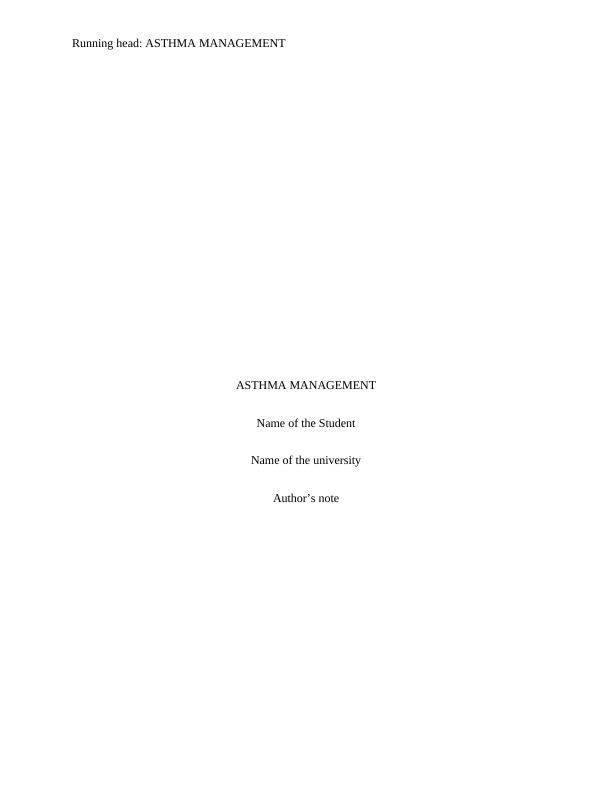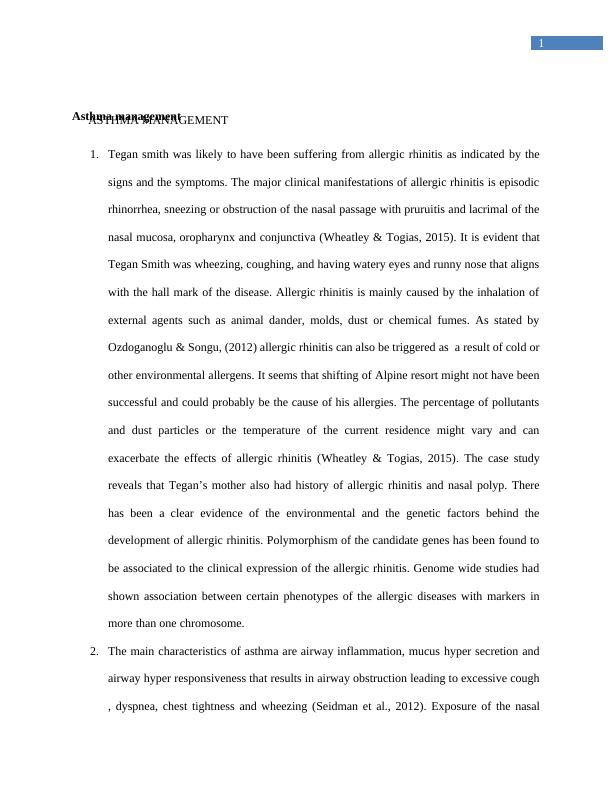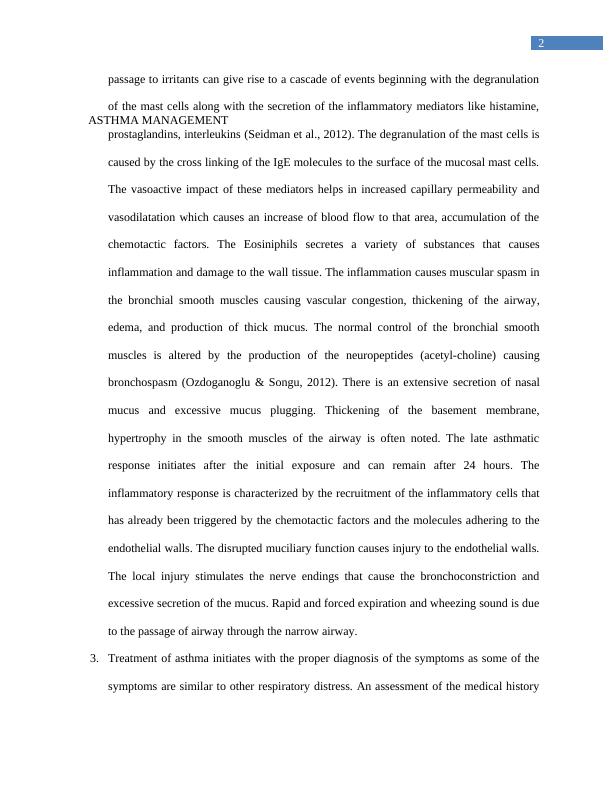The Bronchial asthma management
6 Pages1475 Words237 Views
Added on 2021-05-31
The Bronchial asthma management
Added on 2021-05-31
ShareRelated Documents
Running head: ASTHMA MANAGEMENTASTHMA MANAGEMENTName of the StudentName of the universityAuthor’s note

1ASTHMA MANAGEMENTAsthma management1.Tegan smith was likely to have been suffering from allergic rhinitis as indicated by thesigns and the symptoms. The major clinical manifestations of allergic rhinitis is episodicrhinorrhea, sneezing or obstruction of the nasal passage with pruruitis and lacrimal of thenasal mucosa, oropharynx and conjunctiva (Wheatley & Togias, 2015). It is evident thatTegan Smith was wheezing, coughing, and having watery eyes and runny nose that alignswith the hall mark of the disease. Allergic rhinitis is mainly caused by the inhalation ofexternal agents such as animal dander, molds, dust or chemical fumes. As stated byOzdoganoglu & Songu, (2012) allergic rhinitis can also be triggered as a result of cold orother environmental allergens. It seems that shifting of Alpine resort might not have beensuccessful and could probably be the cause of his allergies. The percentage of pollutantsand dust particles or the temperature of the current residence might vary and canexacerbate the effects of allergic rhinitis (Wheatley & Togias, 2015). The case studyreveals that Tegan’s mother also had history of allergic rhinitis and nasal polyp. Therehas been a clear evidence of the environmental and the genetic factors behind thedevelopment of allergic rhinitis. Polymorphism of the candidate genes has been found tobe associated to the clinical expression of the allergic rhinitis. Genome wide studies hadshown association between certain phenotypes of the allergic diseases with markers inmore than one chromosome.2.The main characteristics of asthma are airway inflammation, mucus hyper secretion andairway hyper responsiveness that results in airway obstruction leading to excessive cough, dyspnea, chest tightness and wheezing (Seidman et al., 2012). Exposure of the nasal

2ASTHMA MANAGEMENTpassage to irritants can give rise to a cascade of events beginning with the degranulationof the mast cells along with the secretion of the inflammatory mediators like histamine,prostaglandins, interleukins (Seidman et al., 2012). The degranulation of the mast cells iscaused by the cross linking of the IgE molecules to the surface of the mucosal mast cells.The vasoactive impact of these mediators helps in increased capillary permeability andvasodilatation which causes an increase of blood flow to that area, accumulation of thechemotactic factors. The Eosiniphils secretes a variety of substances that causesinflammation and damage to the wall tissue. The inflammation causes muscular spasm inthe bronchial smooth muscles causing vascular congestion, thickening of the airway,edema, and production of thick mucus. The normal control of the bronchial smoothmuscles is altered by the production of the neuropeptides (acetyl-choline) causingbronchospasm (Ozdoganoglu & Songu, 2012). There is an extensive secretion of nasalmucus and excessive mucus plugging. Thickening of the basement membrane,hypertrophy in the smooth muscles of the airway is often noted. The late asthmaticresponse initiates after the initial exposure and can remain after 24 hours. Theinflammatory response is characterized by the recruitment of the inflammatory cells thathas already been triggered by the chemotactic factors and the molecules adhering to theendothelial walls. The disrupted muciliary function causes injury to the endothelial walls.The local injury stimulates the nerve endings that cause the bronchoconstriction andexcessive secretion of the mucus. Rapid and forced expiration and wheezing sound is dueto the passage of airway through the narrow airway. 3.Treatment of asthma initiates with the proper diagnosis of the symptoms as some of thesymptoms are similar to other respiratory distress. An assessment of the medical history

End of preview
Want to access all the pages? Upload your documents or become a member.
Related Documents
Asthma Management - Assignmentlg...
|7
|1545
|45
Sample Assignment on Allergiclg...
|5
|1417
|38
The Critical thinking in nursing practicelg...
|10
|3172
|16
Understanding Allergic Asthma: Pathophysiology, Treatment and Educationlg...
|7
|1690
|115
Asthma: Pathophysiology, Treatment and Educationlg...
|7
|1665
|323
Meet Asherine Power Point Presentation 2022lg...
|7
|1236
|18
